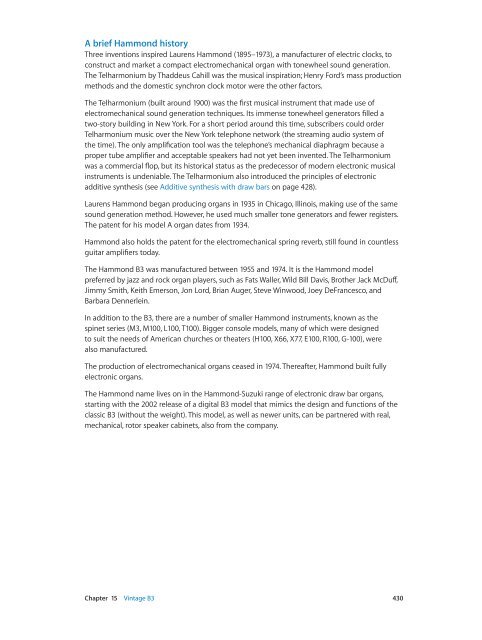Apple MainStage 3 Instruments - MainStage 3 Instruments
Apple MainStage 3 Instruments - MainStage 3 Instruments
Apple MainStage 3 Instruments - MainStage 3 Instruments
You also want an ePaper? Increase the reach of your titles
YUMPU automatically turns print PDFs into web optimized ePapers that Google loves.
A brief Hammond history<br />
Three inventions inspired Laurens Hammond (1895–1973), a manufacturer of electric clocks, to<br />
construct and market a compact electromechanical organ with tonewheel sound generation.<br />
The Telharmonium by Thaddeus Cahill was the musical inspiration; Henry Ford’s mass production<br />
methods and the domestic synchron clock motor were the other factors.<br />
The Telharmonium (built around 1900) was the first musical instrument that made use of<br />
electromechanical sound generation techniques. Its immense tonewheel generators filled a<br />
two-story building in New York. For a short period around this time, subscribers could order<br />
Telharmonium music over the New York telephone network (the streaming audio system of<br />
the time). The only amplification tool was the telephone’s mechanical diaphragm because a<br />
proper tube amplifier and acceptable speakers had not yet been invented. The Telharmonium<br />
was a commercial flop, but its historical status as the predecessor of modern electronic musical<br />
instruments is undeniable. The Telharmonium also introduced the principles of electronic<br />
additive synthesis (see Additive synthesis with draw bars on page 428).<br />
Laurens Hammond began producing organs in 1935 in Chicago, Illinois, making use of the same<br />
sound generation method. However, he used much smaller tone generators and fewer registers.<br />
The patent for his model A organ dates from 1934.<br />
Hammond also holds the patent for the electromechanical spring reverb, still found in countless<br />
guitar amplifiers today.<br />
The Hammond B3 was manufactured between 1955 and 1974. It is the Hammond model<br />
preferred by jazz and rock organ players, such as Fats Waller, Wild Bill Davis, Brother Jack McDuff,<br />
Jimmy Smith, Keith Emerson, Jon Lord, Brian Auger, Steve Winwood, Joey DeFrancesco, and<br />
Barbara Dennerlein.<br />
In addition to the B3, there are a number of smaller Hammond instruments, known as the<br />
spinet series (M3, M100, L100, T100). Bigger console models, many of which were designed<br />
to suit the needs of American churches or theaters (H100, X66, X77, E100, R100, G-100), were<br />
also manufactured.<br />
The production of electromechanical organs ceased in 1974. Thereafter, Hammond built fully<br />
electronic organs.<br />
The Hammond name lives on in the Hammond-Suzuki range of electronic draw bar organs,<br />
starting with the 2002 release of a digital B3 model that mimics the design and functions of the<br />
classic B3 (without the weight). This model, as well as newer units, can be partnered with real,<br />
mechanical, rotor speaker cabinets, also from the company.<br />
Chapter 15 Vintage B3 430
















